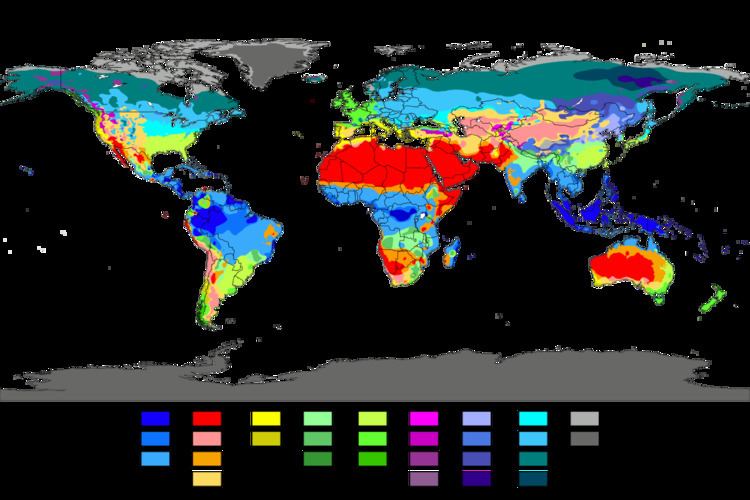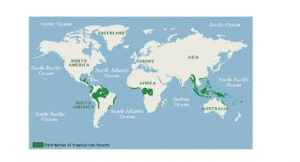Back to: GEOGRAPHY SS2
Welcome to class!
In today’s class, we will be talking about the classification of climate. Enjoy the class!
Classification of Climate

Climate varies from place to place and the following are the common classification of climate:
- The Greek system of classification and
- Koppen system of classification
GREEK SYSTEM OF CLASSIFICATION OF CLIMATE
This is one of the earliest climatic classifications which was made by the Greeks. The basis for the Greek classification is temperature. This system of classification divides the world into three climatic zones. These zones are:
- Torrid zone: This zone is found within the tropics. It is very hot and has a high temperature throughout the year.
- Temperate zone: It is found between the torrid and frigid zone and has a moderate temperature.
- Frigid zone: It is found around the polar regions and It is very cold with low temperature all year round. It has a lot of ice-caps in most of the year.
KOPPEN SYSTEM CLASSIFICATION OF CLIMATE
The basis for Koppen’s classification of climate is temperature and rainfall. He identified five major climatic groups which correspond with the five principal vegetation groups. These climatic groups are represented with capital letters as follows:
Tropical Rainy Climate:
The environment is defined as the total surrounding or medium of any organism in a given area. This includes the physical surroundings, climatic factors and other living organisms in that surrounding.
SPHERES OF THE ENVIRONMENT
The earth as an environment is grouped into four spheres:
- Lithosphere: The solid portion of the environment which contains rocks, sand, soil, minerals etc.
- Hydrosphere: This is the liquid portion of the environment like rivers, lakes and oceans.
- Atmosphere: This is the gaseous portion of the environment where gases like oxygen, nitrogen, carbon dioxide, ozone are found.
- Biosphere: This is the portion of the environment where plants and animals are found. These four spheres of the environment are interrelated and interdependent on each other.
Ecosystem:
An ecosystem is defined as the community of plants and animals living together in harmony and interacting with their physical environment.
In other words, an ecosystem can be defined as the relationship that exists between a living thing and its non-living environment.
Components of Ecosystem
The ecosystem is made up of two main components. These are:
- Abiotic (non-living) component: These are the components like soil, water, gases, sunlight etc. in the environment.
- Biotic component: This is the living component of the ecosystem. It includes plants and animals.
The biotic component can be grouped into three (3)
- Autotrophs: This is also called the producers. They include the green plants which manufacture their own food through a process known as photosynthesis.
- Heterotrophs: These are called primary and secondary consumers. These organisms cannot manufacture their own food but depend directly or indirectly on plants for their own food e.g. man, parasites, saprophytes.
- Decomposers: These are microorganisms that decompose dead organic matter to release nutrients required by producers to prepare their food e.g. Fungi and bacteria holistically, the components of an ecosystem can be grouped into the following:
- Land (soil)
- Water (Lake, Oceans)
- plants
- Animal
- Drainage (river)
- Climate (Atmosphere)
INTERDEPENDENCE WITHIN THE ECOSYSTEM
Interdependence is the word used to describe the relationship between the components of the ecosystem. This is because components in an ecosystem depend on one another and they cannot exist in isolation. A state of inter-dependence within the ecosystem is best achieved where the components are undisturbed.
Inter-dependence in an ecosystem exists in three ways:
- Interdependence within Abiotic components e.g. The weathering of rock to form soil or the evaporation of water to form cloud etc.
- Interdependence within Abiotic components e.g. Animals depends on plants for food or the exchange of oxygen and carbon dioxide by plants and animals.
- Interdependence between the biotic and abiotic components e.g. plants depend on soil for support and nutrients, Autotrophs convert sunlight, energy. Water and carbon dioxide during photosynthesis to produce food etc.
Environmental balance
Environmental balance refers to the ways of recycling matter and the flow of energy within an ecosystem to ensure continuous supply or availability.
Environmental balance is achieved through the following processes:
- Hydrological (water) cycle
- Carbon cycle
- Nitrogen cycle
- Mineral nutrient cycle
- Food chain and food web. (For details, see pages 115 – 118 of Essential Geography)
TYPES OF CLIMATE
Types of Climate are:
- Cold climate: This is divided into the polar climate and the Arctic or Tundra climate
- Polar climate: It is located around lat 900N and S of the equator. It covers areas like Greenland and Iceland. Temperature is below 00c. Strong winds and low rainfall (10-15cm). Sparse population
- Tundra climate: It is located around the arctic and antarctic circles (lat 600 and 900N and South of the equator). Covers countries like Canada, Norway, Alaska and part of Eurasia. Characterized by low temperature, inequalities of the length of day and night; prolonged winter, as such, no true tree; shorter summer encourages the growth of low shrub; precipitation is during autumn and winter periods; orens, sheep, bears, foxes and wolves are in place. Cool temperate West margin 40c – 170c temperature range; 600 – 800 min annual rainfall; deciduous trees; coniferous forest; foxes and squirrels are prevalent.
- Cool climate: Regions with mid-latitude cyclones within lat 450 and 600N and S of the equator. There are three types which are:
- Cool temperate East margin: Areas bordering the Atlantic ocean found between lat 400 – 500N and S of the equator covers places like N –E of North America and Argentina; rainfall is 700- 1,600mm: has coniferous forest and land; cultivation of cereals crops like rice, maize oats barleys.
- Cool temperate continental: located 400 and 450 N and S of the equator. Covers place like east-central Europe; South Canada and North America high temperature (160c) and at times fall below 00c rainfall is 508mm; temperate grassland called prairies in Canada, steppers in Eurasia, Pampas in Argentina, Veld in South Africa and Downs in Australia scarcity of trees because of the scarcity of rainfall, long drought and severe winter; nomadic farming prevalent.
- Warm climate: There are two types of warm climate which are:
Warm Temperate Western Margin (Mediterranean type):
300 and 450N and S of the equator. Covers South Europe (France, Italy, Portugal, Spain, North Africa (Morocco, Libya, Tunisia), South America (Central Chile), California in the USA and South West of South Africa.
Characteristics
It is characterized by a dry and hot summer with a temperature range of between 210c – 270c; high temperature throughout the year; rainfall is 600 – 840mm. Drought- resistant plants grow; the presence of small shrubs patches like acacia, Rosemary and Laurel which are grown; Orchard farming with a wide range of citrus fruits are grown
Warm Temperate Eastern Margin (china type or gulf climate):
It is found between lat 200 and 400N and S of the equator in places like South East Australia, Central part of South America, Central China, south Japan, New Zealand and South East US.
Characteristics
It is characterized by a warm moist summer and cool dry winter. 40c – 260c of temperature; moderate rainfall between 635mm and 1,524mm, evergreen and deciduous forest because of continuous rainfall all year round; cultivation of maize, cotton, sugar, rice and sugar- are extensively carried out.
The equatorial climate within Lat 50N and S of the equator
Places that come under the equatorial region are: Congo Basin of Central Africa, Amazon Basin of South America, South East Asia and the Central Area of West Africa; Temperature range is 200c – 260c(high); conventional rainfall and thunderstorms a lightening; maximum temperature are in March and September when the sun is overhead the equator; tropical rainforest and equatorial trees; the presence of rivers; the presence of economic trees such as iroko, Sapele, Ebony, African walnut etc and plantation agriculture such as rubber, cocoa, oil palms etc. The pygmies live here around Congo Basin and Red Indians of the Amazon Basin.
Desert Climate
Desert climate is of two types; they are Cold desert climate and hot desert climate:
Hot Climate: They are classified into two; which are: (i) Equatorial climate within Lat 50N and S of the equator. Places that come under the equatorial region are: Congo Basin of Central Africa, Amazon Basin of South America, South-East Asia and the Central Area of West Africa; Temperature range is 200c – 260c(high); conventional rainfall and thunderstorms a lightening; maximum temperature are in March and September when the sun is overhead the equator; tropical rainforest and equatorial trees; the presence of rivers; the presence of economic trees such as iroko, Sapele, Ebony, African walnut etc and plantation agriculture such as rubber, cocoa, oil palms etc. The pigmies live here around Congo Basin and Red Indians of the Amazon Basin

EVALUATION
- What is the Word ‘Interdependence’ mean?
- What is Environmental balance and how is it achieved?
In our next class, we will be talking about Environmental Resources. We hope you enjoyed the class.
Should you have any further question, feel free to ask in the comment section below and trust us to respond as soon as possible.
